
Discover Eastern Europe: 10-Day Journey through Prague, Dresden, and Berlin
 10 Day Tour of Prague and Berlin
10 Day Tour of Prague and Berlin
Overview
Trip Map
Itinerary
Inclusions
Reviews







10 Days 9 Nights
Best Time: Jan-Dec
Jewish Heritage
WWII History & Communist Era
Experience a captivating 10-day journey through the heart of Central Europe, exploring the rich histories of Prague, Dresden, and Berlin. Wander Prague’s Charles Bridge, the Jewish Quarter, and Prague Castle, uncovering WWII and Communist legacies. Travel by train to Berlin, stopping in Dresden along the way, where you’ll visit the stunning Zwinger Palace. In Berlin, discover the Brandenburg Gate, Holocaust Memorial, and Berlin Wall. With private guided tours, immersive day trips, and expert travel guidance via our app, this trip reveals the essence of Jewish heritage and Europe’s wartime past.
- Wander Prague's Royal Route and explore Prague Castle on a private guided tour.
- Discover the hidden histories and legends of Prague's Jewish Quarter.
- See Berlin's Holocaust Memorial, Brandenburg Gate, and the remnants of the Berlin Wall.
- Take an excursion to Sachsenhausen Concentration Camp to learn about Nazi atrocities.
- Uncover hidden courtyards and the remains of a synagogue in Berlin’s former Jewish neighborhood.
Experience a captivating 10-day journey through the heart of Central Europe, exploring the rich histories of Prague, Dresden, and Berlin. Wander Prague’s Charles Bridge, the Jewish Quarter, and Prague Castle, uncovering WWII and Communist legacies. Travel by train to Berlin, stopping in Dresden along the way, where you’ll visit the stunning Zwinger Palace. In Berlin, discover the Brandenburg Gate, Holocaust Memorial, and Berlin Wall. With private guided tours, immersive day trips, and expert travel guidance via our app, this trip reveals the essence of Jewish heritage and Europe’s wartime past.
- Wander Prague's Royal Route and explore Prague Castle on a private guided tour.
- Discover the hidden histories and legends of Prague's Jewish Quarter.
- See Berlin's Holocaust Memorial, Brandenburg Gate, and the remnants of the Berlin Wall.
- Take an excursion to Sachsenhausen Concentration Camp to learn about Nazi atrocities.
- Uncover hidden courtyards and the remains of a synagogue in Berlin’s former Jewish neighborhood.

Astronomical Clock
Architecture

Prague Castle
Castles & Chateaux

Charles Bridge
Historic Landmarks

Wenceslas Square
European History

Old Town
Historic Landmarks

The Brandenburg Gate
Historic Landmarks

The Berlin Wall
Historic Landmarks

Checkpoint Charlie
European History

The Reichstag
Architecture
Must see sights

Astronomical Clock
Architecture

Prague Castle
Castles & Chateaux

Charles Bridge
Historic Landmarks

Wenceslas Square
European History

Old Town
Historic Landmarks

The Brandenburg Gate
Historic Landmarks

The Berlin Wall
Historic Landmarks

Checkpoint Charlie
European History

The Reichstag
Architecture
Starting from
$1925
per person
 Not included
Not included Secure Your Customizable Trip
Enter your details to embark on a journey that can be tailored just for you.
Start
Travelers
Add Room
Remove Room
Preferred Hotel Stars
Craft Your Own Itinerary
Select your interests and destinations for a trip plan inspired by you.
Trip Map & Itinerary
Enable/Disable Map Scrolling
Click To Make Map Interactive

Trip Timeline
 Edit Details
Edit DetailsArrival
4 nights
Prague
Czech Republic
Train: 2.5h
Train: 2h
5 nights
Berlin
Germany
Departure
Day-By-Day Itinerary
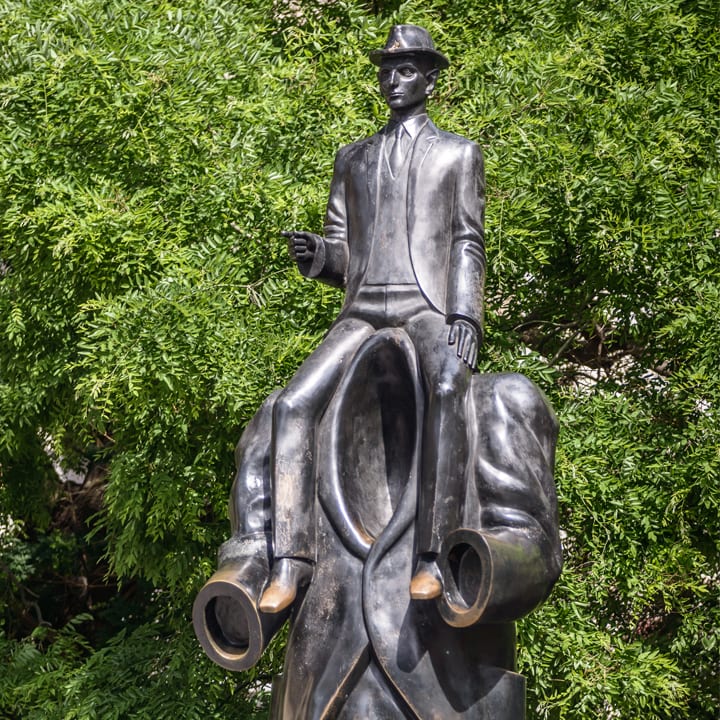
Day 1
Arrive Prague
View More
Day 1
Arrive Prague




To Be Determined
Arrival in Prague Airport & Transfer by Taxi
Prague has one main airport, Václav Havel Airport Prague, where almost all visitors arrive. Taxis are available directly at the terminal exit, or you can arrange a private transfer for added convenience.

Day 1
Arrive Prague
View More


Day 1
Arrive Prague





To Be Determined:
Airport Transfer
Mid-Day/Afternoon:
Jewish Quarter
Late Afternoon/Early Evening:
New Town
Early Evening/Evening:
Evening Boat Cruise


Day 2
Prague
View More
Day 2
Prague



9:00 AM - 12:30 PM
Prague Castle & Royal Route Guided Walk
On this charming guided walk, you will explore the Prague Castle, the largest castle complex in all of Europe. To reach the castle you will trace the Royal Coronation Route and cross the Charles Bridge, whose “speaking stones” reveal the amazing and often cruel history that occurred there. Your tour guide will then take you either through the castle courtyards and into the dramatic St. Vitus Cathedral in the center of the castle complex, or through the upper part of the castle district around the oversized palaces of the old Catholic nobility and the top of the Castle Steps for incomparable views over the red rooftops of the Little Quarter.

Charles Bridge
Cross the river dividing Prague's most historic neighborhoods, and experience one of Europe's most iconic landmarks.
Show More

Maltese Square & Lennon Wall
See a historic wall that has been covered in John Lennon-inspired graffiti since Communist days.
Show More

Prague Castle
Prague Castle is one of the main attractions in Prague and is also the largest castle complex in the world.
Show More

Charles Bridge
Cross the river dividing Prague's most historic neighborhoods, and experience one of Europe's most iconic landmarks.
Show More

Maltese Square & Lennon Wall
See a historic wall that has been covered in John Lennon-inspired graffiti since Communist days.
Show More

Prague Castle
Prague Castle is one of the main attractions in Prague and is also the largest castle complex in the world.
Show More

Charles Bridge
Cross the river dividing Prague's most historic neighborhoods, and experience one of Europe's most iconic landmarks.
Show More
prev
next

Day 2
Prague
View More

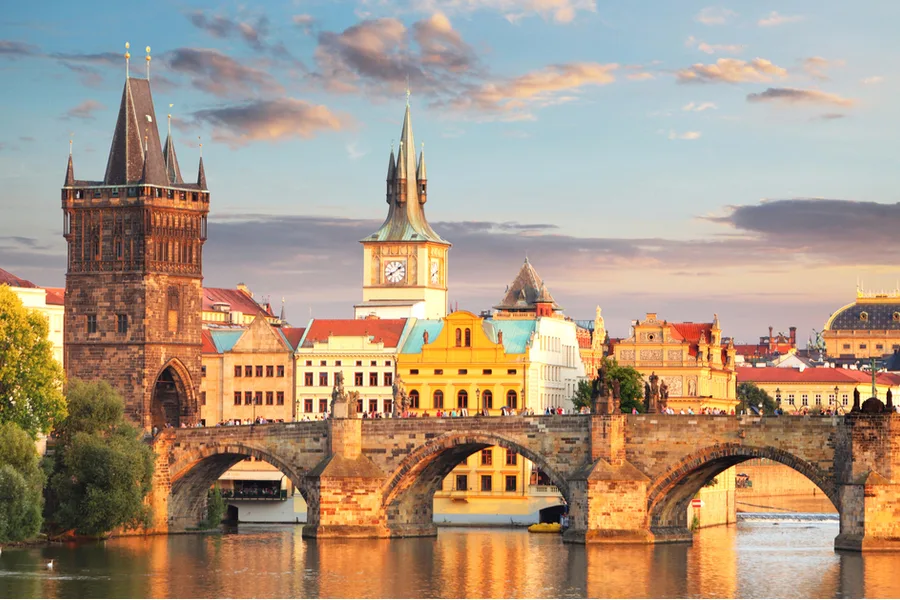
Charles Bridge
 Highlight of Royal Route Guided Tour
Highlight of Royal Route Guided TourCross the river dividing Prague's most historic neighborhoods, and experience one of Europe's most iconic landmarks.
Bridge construction began in 1357 under King Charles IV (hence the name), and it was the only bridge across the Vltava River until 1841. 30 baroque statues of saints line the bridge, and it is filled with street artists and entertainers. Not to be missed.

Maltese Square & Lennon Wall
 Highlight of Royal Route Guided Tour
Highlight of Royal Route Guided TourSee a historic wall that has been covered in John Lennon-inspired graffiti since Communist days.
The wall has been covered in graffiti since the 1960s, and during Communism anti-regime sentiment was common. John Lennon's assassination inspired grafitti reflecting his song, Imagine, which earned the wall its current moniker. It is now a favorite gathering place for tourists, and musicians sometimes congregate there as well. Just around the corner is the Maltese Square, which is one of Prague's more quaint and relaxed public spaces, despite being just off the main tourist route.

Prague Castle
 Highlight of Royal Route Guided Tour
Highlight of Royal Route Guided TourPrague Castle is one of the main attractions in Prague and is also the largest castle complex in the world.
The Prague Castle is the largest castle complex in the world with structures dating back to the 9th century. The St Vitus Cathedral and Basilica of St George can be found within the castle walls. The Prague Castle also includes several gardens, palaces, and a monastery. This castle was the seat of power for the Kings of Bohemia, Holy Roman Emperors, and presidents of former Czechoslovakia. Prague Castle is a UNESCO world heritage site and is one of the most visited places in the country.

Charles Bridge
 Highlight of Royal Route Guided Tour
Highlight of Royal Route Guided TourCross the river dividing Prague's most historic neighborhoods, and experience one of Europe's most iconic landmarks.
Bridge construction began in 1357 under King Charles IV (hence the name), and it was the only bridge across the Vltava River until 1841. 30 baroque statues of saints line the bridge, and it is filled with street artists and entertainers. Not to be missed.

Maltese Square & Lennon Wall
 Highlight of Royal Route Guided Tour
Highlight of Royal Route Guided TourSee a historic wall that has been covered in John Lennon-inspired graffiti since Communist days.
The wall has been covered in graffiti since the 1960s, and during Communism anti-regime sentiment was common. John Lennon's assassination inspired grafitti reflecting his song, Imagine, which earned the wall its current moniker. It is now a favorite gathering place for tourists, and musicians sometimes congregate there as well. Just around the corner is the Maltese Square, which is one of Prague's more quaint and relaxed public spaces, despite being just off the main tourist route.

Prague Castle
 Highlight of Royal Route Guided Tour
Highlight of Royal Route Guided TourPrague Castle is one of the main attractions in Prague and is also the largest castle complex in the world.
The Prague Castle is the largest castle complex in the world with structures dating back to the 9th century. The St Vitus Cathedral and Basilica of St George can be found within the castle walls. The Prague Castle also includes several gardens, palaces, and a monastery. This castle was the seat of power for the Kings of Bohemia, Holy Roman Emperors, and presidents of former Czechoslovakia. Prague Castle is a UNESCO world heritage site and is one of the most visited places in the country.

Charles Bridge
 Highlight of Royal Route Guided Tour
Highlight of Royal Route Guided TourCross the river dividing Prague's most historic neighborhoods, and experience one of Europe's most iconic landmarks.
Bridge construction began in 1357 under King Charles IV (hence the name), and it was the only bridge across the Vltava River until 1841. 30 baroque statues of saints line the bridge, and it is filled with street artists and entertainers. Not to be missed.
prev
next


Day 3
Prague
View More
Day 3
Prague


Early Morning to Afternoon
Excursion to the Terezín Concentration Camp
The former Terezín Concentration Camp is where the Nazis created a model “Jewish Town” intended to fool the Red Cross and other observers into thinking that the Jews in Europe were being humanely treated. While the ruse worked, the reality, of course, was that almost all of the Jews located in Terezín were killed, either in Terezín or later in Auschwitz. You can visit the ghetto museum, barracks, and prison, and see exhibitions of music, artworks, literature, and a theater, all created by the prisoners themselves.

Terezín Memorial - The National Cemetery
Respectfully visit a graveyard containing over 2,300 victims of the Holocaust.
Show More

Terezín Memorial - The National Cemetery
Respectfully visit a graveyard containing over 2,300 victims of the Holocaust.
Show More

Terezín Memorial - The National Cemetery
Respectfully visit a graveyard containing over 2,300 victims of the Holocaust.
Show More

Terezín Memorial - The National Cemetery
Respectfully visit a graveyard containing over 2,300 victims of the Holocaust.
Show More

Terezín Memorial - The National Cemetery
Respectfully visit a graveyard containing over 2,300 victims of the Holocaust.
Show More
prev
next

Day 3
Prague
View More


Terezín Memorial - The National Cemetery
 Highlight of Terezín Concentration Camp
Highlight of Terezín Concentration CampRespectfully visit a graveyard containing over 2,300 victims of the Holocaust.
The cemetery was created after the end of the war to hold the remains exhumed from the mass graves. Many were executed or died from disease and exhaustion caused by forced labor and poor conditions. The Nazi response was to simply bury them in mass graves, and survivors wanted a proper cemetery to treat the dead with respect and act as a memorial.

Terezín Memorial - The National Cemetery
 Highlight of Terezín Concentration Camp
Highlight of Terezín Concentration CampRespectfully visit a graveyard containing over 2,300 victims of the Holocaust.
The cemetery was created after the end of the war to hold the remains exhumed from the mass graves. Many were executed or died from disease and exhaustion caused by forced labor and poor conditions. The Nazi response was to simply bury them in mass graves, and survivors wanted a proper cemetery to treat the dead with respect and act as a memorial.

Terezín Memorial - The National Cemetery
 Highlight of Terezín Concentration Camp
Highlight of Terezín Concentration CampRespectfully visit a graveyard containing over 2,300 victims of the Holocaust.
The cemetery was created after the end of the war to hold the remains exhumed from the mass graves. Many were executed or died from disease and exhaustion caused by forced labor and poor conditions. The Nazi response was to simply bury them in mass graves, and survivors wanted a proper cemetery to treat the dead with respect and act as a memorial.

Terezín Memorial - The National Cemetery
 Highlight of Terezín Concentration Camp
Highlight of Terezín Concentration CampRespectfully visit a graveyard containing over 2,300 victims of the Holocaust.
The cemetery was created after the end of the war to hold the remains exhumed from the mass graves. Many were executed or died from disease and exhaustion caused by forced labor and poor conditions. The Nazi response was to simply bury them in mass graves, and survivors wanted a proper cemetery to treat the dead with respect and act as a memorial.

Terezín Memorial - The National Cemetery
 Highlight of Terezín Concentration Camp
Highlight of Terezín Concentration CampRespectfully visit a graveyard containing over 2,300 victims of the Holocaust.
The cemetery was created after the end of the war to hold the remains exhumed from the mass graves. Many were executed or died from disease and exhaustion caused by forced labor and poor conditions. The Nazi response was to simply bury them in mass graves, and survivors wanted a proper cemetery to treat the dead with respect and act as a memorial.
prev
next


Day 4
Prague
View More
Day 4
Prague



9:00 AM - 12:30 PM
Guided Tour of Velvet Revolution Sites
Commentating on the political upheavals of 1989, the writer and historian Timothy Garton Ash famously pointed out that while Poland had taken 10 years to achieve regime change and Hungary had taken 10 months, Czechoslovakia had achieved the same in a mere 10 days. And the transition from a totalitarian Communist state to nascent democracy was achieved almost without violence or the shedding of blood, hence in the moniker Velvet Revolution. On this tour, you will visit the sites most famously associated with the Revolution, including the residence of the dissident and future president Vaclav Havel, the former headquarters of the infamous STB secret police, and Wenceslas Square.

Day 4
Prague
View More


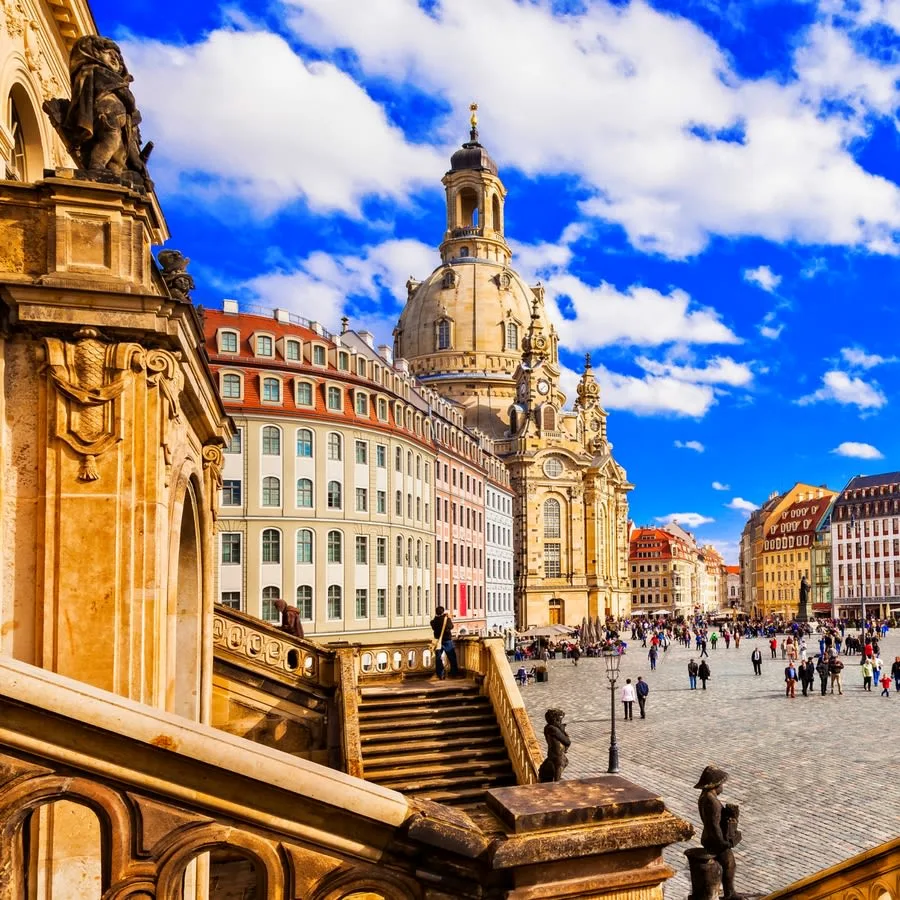
Day 5
Prague to Berlin
View More
Day 5
Prague to Berlin

10:28 - 12:50, 18:54 - 20:43
Rail Journey to Berlin with a Stop in Dresden
The enchanting Saxon capital of Dresden is located roughly mid-way between Prague and Berlin, making it a perfect stop on this approximately 5 hour journey. Lockers in the rail station make it easy to drop your bags and make the short walk from the station to the beautiful Old Town. Dresden's long history as a royal residence for the Kings of Saxony transformed their home over the centuries into a splendid architectural jewel. Because of its fascinating baroque and rococo city center, Dresden was often called “Florence on the Elbe”. Also a must see is the Zwinger, a palace complex containing several outstanding art musuems.

Day 5
Prague to Berlin
View More



Day 6
Berlin
View More
Day 6
Berlin



9:00 AM - 12:00 PM
Highlights of Berlin Guided Walking Tour
On this 3 hour tour, your guide will show you the highlights of Berlin and help you understand what makes this city so unique. Sites visited will include the boulevard Unter den Linden, the Gendarmenmarkt, Check Point Charlie, remnants of the Berlin Wall, Potsdamer Platz, the Holocaust Memorial, the Brandenburg Gate, and the Reichstag.

Brandenburg Gate
Quadriga. Hey, There's a Word to Know When Learning About this Historic Gate
Show More

Reichstag
Make your way to the top of the dome enjoying amazing views and looking down at debating members of the German Parliament below.
Show More

Brandenburg Gate
Quadriga. Hey, There's a Word to Know When Learning About this Historic Gate
Show More

Reichstag
Make your way to the top of the dome enjoying amazing views and looking down at debating members of the German Parliament below.
Show More

Brandenburg Gate
Quadriga. Hey, There's a Word to Know When Learning About this Historic Gate
Show More

Reichstag
Make your way to the top of the dome enjoying amazing views and looking down at debating members of the German Parliament below.
Show More
prev
next

Day 6
Berlin
View More

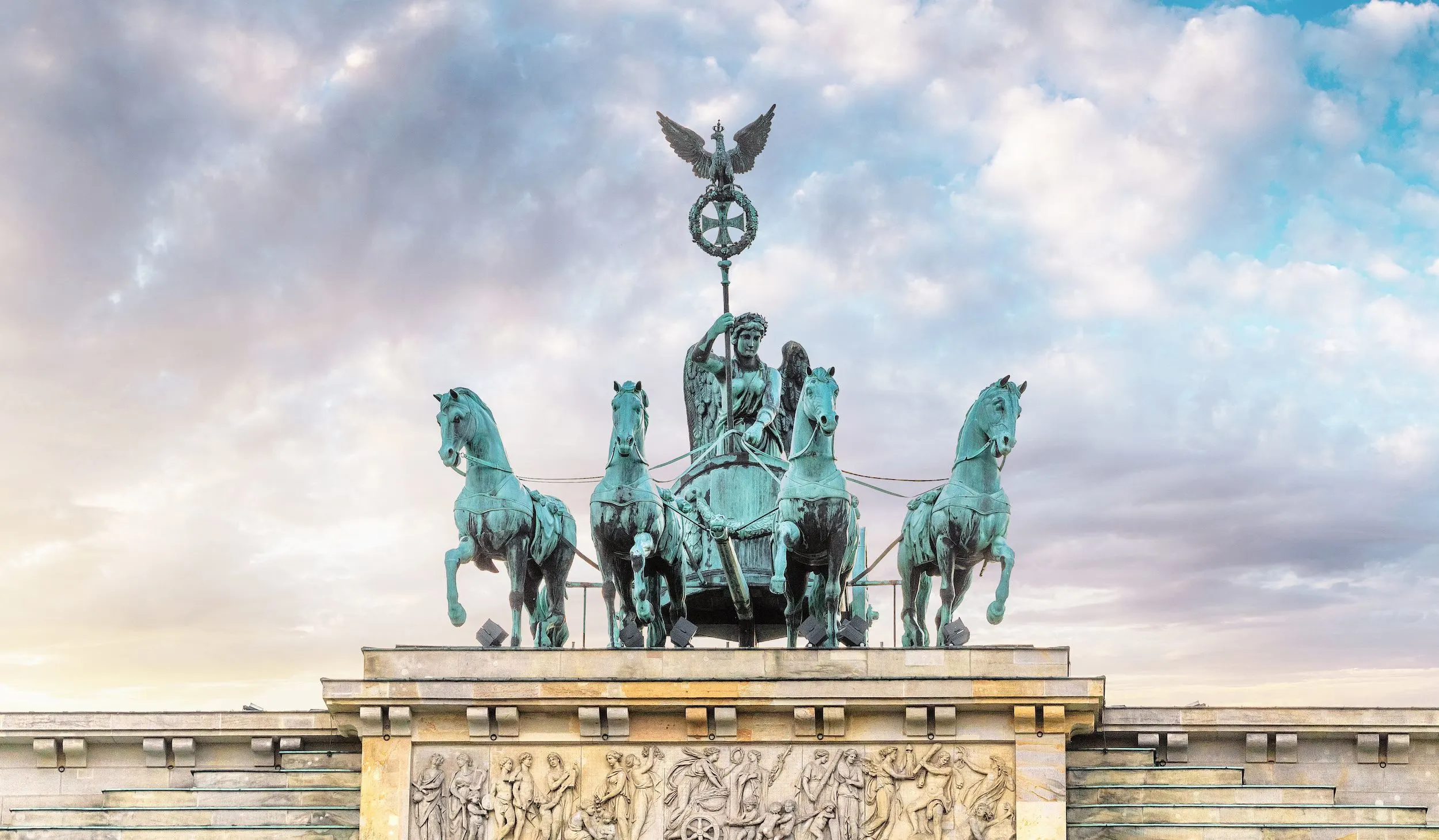
Brandenburg Gate
 Highlight of Guided Walking Tour of Berlin
Highlight of Guided Walking Tour of BerlinQuadriga. Hey, There's a Word to Know When Learning About this Historic Gate
The Brandenburg Gate was built as a symbol of peace, perverted into a symbol of power by the Nazis, and became a symbol of division during the Cold War. Now, however, it is a symbol of reunification. Completed in 1791, it was topped by the quadriga, a chariot drawn by four horses driven by the goddess of peace. Napoleon seized the quadriga as a spoil of war, but after his defeat, it was returned to the city and met by cheering crowds along the way, transforming the goddess of peace into a goddess of victory, holding a Germanic cross.

Reichstag
 Highlight of Guided Walking Tour of Berlin
Highlight of Guided Walking Tour of BerlinMake your way to the top of the dome enjoying amazing views and looking down at debating members of the German Parliament below.
Officially, the Reichstag is actually the Bundestag, which means the federal parliament. The Reichstag was reduced to a ruined shell by arson in 1933 and by World War II fighting, but it was rebuilt with a striking egg-shaped glass dome. Visitors are given a free audio guide that discusses the building’s history and architecture, while also orientating you to the sites of Berlin. It is an excellent introduction to the city. Note that it is usually necessary to book well in advance!

Brandenburg Gate
 Highlight of Guided Walking Tour of Berlin
Highlight of Guided Walking Tour of BerlinQuadriga. Hey, There's a Word to Know When Learning About this Historic Gate
The Brandenburg Gate was built as a symbol of peace, perverted into a symbol of power by the Nazis, and became a symbol of division during the Cold War. Now, however, it is a symbol of reunification. Completed in 1791, it was topped by the quadriga, a chariot drawn by four horses driven by the goddess of peace. Napoleon seized the quadriga as a spoil of war, but after his defeat, it was returned to the city and met by cheering crowds along the way, transforming the goddess of peace into a goddess of victory, holding a Germanic cross.

Reichstag
 Highlight of Guided Walking Tour of Berlin
Highlight of Guided Walking Tour of BerlinMake your way to the top of the dome enjoying amazing views and looking down at debating members of the German Parliament below.
Officially, the Reichstag is actually the Bundestag, which means the federal parliament. The Reichstag was reduced to a ruined shell by arson in 1933 and by World War II fighting, but it was rebuilt with a striking egg-shaped glass dome. Visitors are given a free audio guide that discusses the building’s history and architecture, while also orientating you to the sites of Berlin. It is an excellent introduction to the city. Note that it is usually necessary to book well in advance!

Brandenburg Gate
 Highlight of Guided Walking Tour of Berlin
Highlight of Guided Walking Tour of BerlinQuadriga. Hey, There's a Word to Know When Learning About this Historic Gate
The Brandenburg Gate was built as a symbol of peace, perverted into a symbol of power by the Nazis, and became a symbol of division during the Cold War. Now, however, it is a symbol of reunification. Completed in 1791, it was topped by the quadriga, a chariot drawn by four horses driven by the goddess of peace. Napoleon seized the quadriga as a spoil of war, but after his defeat, it was returned to the city and met by cheering crowds along the way, transforming the goddess of peace into a goddess of victory, holding a Germanic cross.

Reichstag
 Highlight of Guided Walking Tour of Berlin
Highlight of Guided Walking Tour of BerlinMake your way to the top of the dome enjoying amazing views and looking down at debating members of the German Parliament below.
Officially, the Reichstag is actually the Bundestag, which means the federal parliament. The Reichstag was reduced to a ruined shell by arson in 1933 and by World War II fighting, but it was rebuilt with a striking egg-shaped glass dome. Visitors are given a free audio guide that discusses the building’s history and architecture, while also orientating you to the sites of Berlin. It is an excellent introduction to the city. Note that it is usually necessary to book well in advance!
prev
next

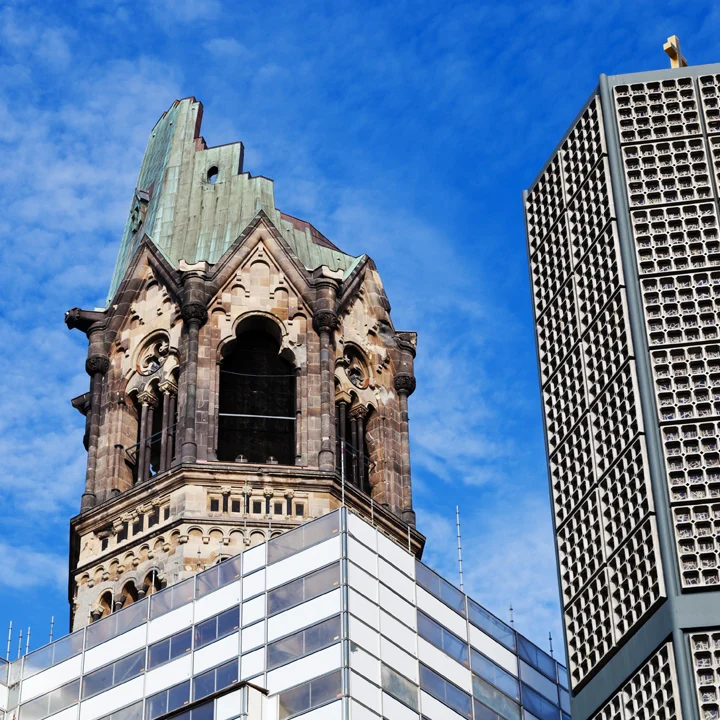
Day 7
Berlin
View More
Day 7
Berlin



Morning/Mid-Day
Stroll the Kurfürstendamm in West Berlin
In the 1920's the elegant, tree-line boulevard known as the Kurfürstendamm was the center of Berlin's nightlife and leisure scene, attracting writers, film stars, and artists. WWII left it in ruins, and today at the end of the boulevard you'll discover a chilling reminder of that destruction: the purposefully unrecontructed remains of the Memorial Church. During the Cold War, the Kurfürstendamm and its surroundings were central to West Berlin's revitalized identity. This was perhaps best symbolized by the famous KaDeWe, the gigantic department store which served as a symbol of market capitalism lodged in the heart of the Iron Curtain.

Berlin Zoo
Visit Germany's Oldest and Best Known Zoo.
Show More

KaDeWe
Shop in the iconic department store of capitalist West Berlin
Show More

Memorial Church
Remind yourself of war's destructiveness by visiting the ruins of this church destroyed during WWII.
Show More

Story of Berlin Museum
Take an interactive crash course in Berlin history. (Re-opening Autumn 2021)
Show More

Berlin Zoo
Visit Germany's Oldest and Best Known Zoo.
Show More

KaDeWe
Shop in the iconic department store of capitalist West Berlin
Show More

Memorial Church
Remind yourself of war's destructiveness by visiting the ruins of this church destroyed during WWII.
Show More

Story of Berlin Museum
Take an interactive crash course in Berlin history. (Re-opening Autumn 2021)
Show More
prev
next

Day 7
Berlin
View More

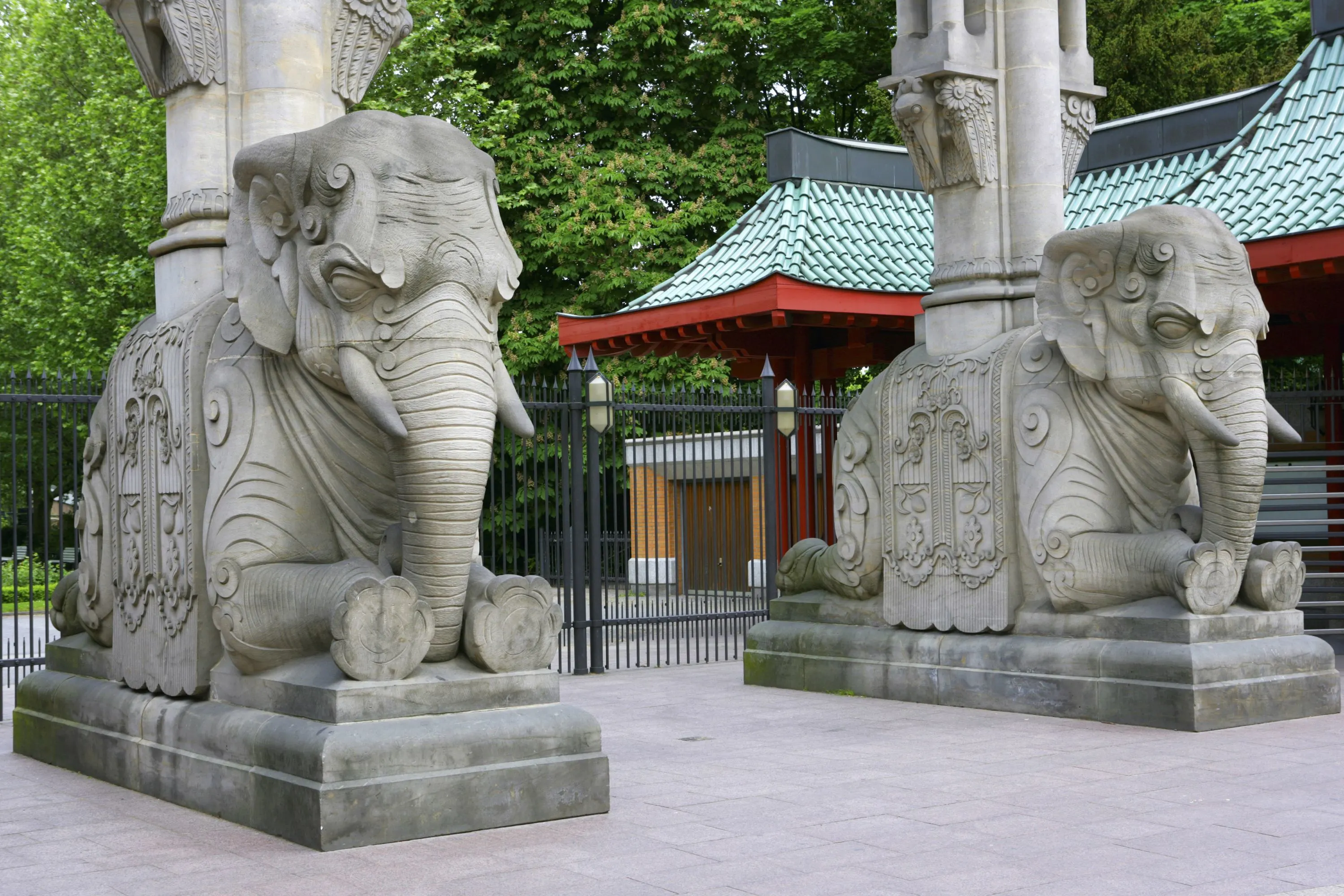
Berlin Zoo
 Highlight of City West
Highlight of City WestVisit Germany's Oldest and Best Known Zoo.
Founded in 1844, the Zoologischer Garten Berlin was the first zoo in Germany and features some wonderful animal-inspired architecture as well. The original animals were donated by King Frederick William IV of Prussia, and it now has a collection of around 20,500 animals representing 1,500 different species. The zoo’s aquarium opened in 1913 and now contains one of the largest collections of aquatic life in Europe.
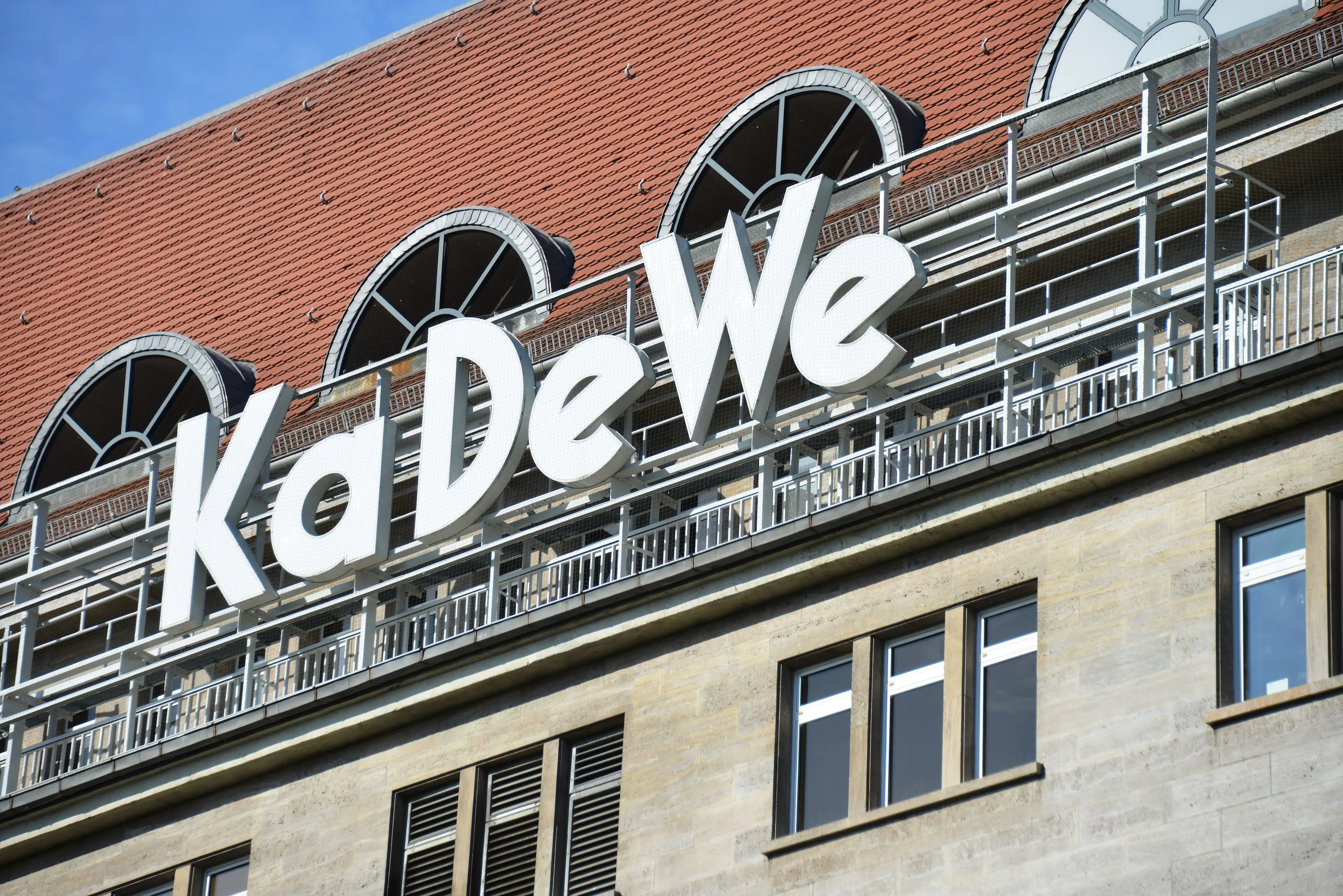
KaDeWe
 Highlight of City West
Highlight of City WestShop in the iconic department store of capitalist West Berlin
Opened in 1907, the Kaufhaus des Westens, or KaDeWe, quickly became a temple of luxury in a rapidly modernising city. It took off again following the German post-war economic miracle and gained new impetus again following German reunification. During Communism, due to it's proximity to East Germany, it became a symbol of the material wealth of the West in comparison to that of countries stuck behind the Iron Curtain.

Memorial Church
 Highlight of City West
Highlight of City WestRemind yourself of war's destructiveness by visiting the ruins of this church destroyed during WWII.
After its destruction in WWII, the Kaiser Wilhelm Memorial Church was partially rebuilt in modernist style, and partially left in ruins as a powerful reminder of the war. Built-in the 1890s, Kaiser Wilhelm II hoped to inspire the secular proletariat to return to traditional religious values. The neo-Gothic design became ever more colorful as Wilhelm insisted on more bling. The small exhibition inside shows the wartime destruction and a “before and after” model of the city center.
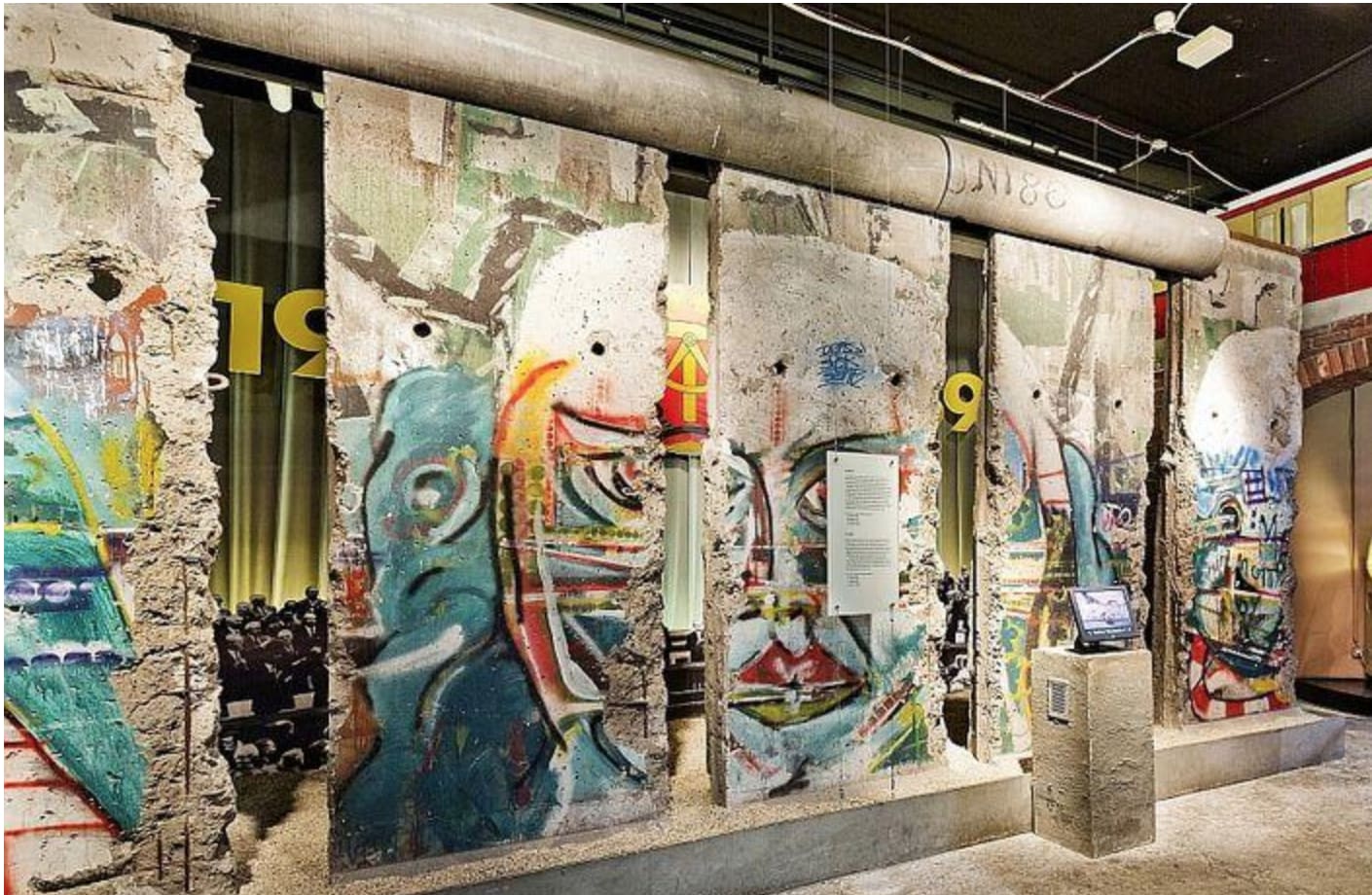
Story of Berlin Museum
 Highlight of City West
Highlight of City WestTake an interactive crash course in Berlin history. (Re-opening Autumn 2021)
This museum uses reconstructed street scapes, homes, and other interactive exibits to give you good feeling for the atmosphere of Berlin during it's long and often times turbulent history, including during the Nazi and Communist era. You can also tour an underground nuclear shelter.

Berlin Zoo
 Highlight of City West
Highlight of City WestVisit Germany's Oldest and Best Known Zoo.
Founded in 1844, the Zoologischer Garten Berlin was the first zoo in Germany and features some wonderful animal-inspired architecture as well. The original animals were donated by King Frederick William IV of Prussia, and it now has a collection of around 20,500 animals representing 1,500 different species. The zoo’s aquarium opened in 1913 and now contains one of the largest collections of aquatic life in Europe.

KaDeWe
 Highlight of City West
Highlight of City WestShop in the iconic department store of capitalist West Berlin
Opened in 1907, the Kaufhaus des Westens, or KaDeWe, quickly became a temple of luxury in a rapidly modernising city. It took off again following the German post-war economic miracle and gained new impetus again following German reunification. During Communism, due to it's proximity to East Germany, it became a symbol of the material wealth of the West in comparison to that of countries stuck behind the Iron Curtain.

Memorial Church
 Highlight of City West
Highlight of City WestRemind yourself of war's destructiveness by visiting the ruins of this church destroyed during WWII.
After its destruction in WWII, the Kaiser Wilhelm Memorial Church was partially rebuilt in modernist style, and partially left in ruins as a powerful reminder of the war. Built-in the 1890s, Kaiser Wilhelm II hoped to inspire the secular proletariat to return to traditional religious values. The neo-Gothic design became ever more colorful as Wilhelm insisted on more bling. The small exhibition inside shows the wartime destruction and a “before and after” model of the city center.

Story of Berlin Museum
 Highlight of City West
Highlight of City WestTake an interactive crash course in Berlin history. (Re-opening Autumn 2021)
This museum uses reconstructed street scapes, homes, and other interactive exibits to give you good feeling for the atmosphere of Berlin during it's long and often times turbulent history, including during the Nazi and Communist era. You can also tour an underground nuclear shelter.
prev
next


Day 8
Berlin
View More
Day 8
Berlin


9:00 AM - 12:00 PM
Berlin in World War II and the Cold War - A Guided Tour
Berlin hides a turbulent past scarred by Nazism and Communism, and on this 3 hour guided tour you will uncover this fascinating history. You will visit the locations where Hitler’s bunker and the SS and Gestapo headquarters once stood, and see remnants of the Cold War such as Check Point Charlie and sections of the Berlin Wall.

Topography of Terror
Learn about the horrors of Nazism and the security apparatus it used to enforce its will in this documentation center.
Show More

Hitler's Bunker
The site of the bunkers where the Nazi leadership holed up during the final days of World War II, and where Hitler committed suicide on April 30th, 1945.
Show More

Reichstag
Make your way to the top of the dome enjoying amazing views and looking down at debating members of the German Parliament below.
Show More

Holocaust Memorial
Wander amongst 2,711 columns forming a vast mazelike Holocaust memorial.
Show More

Topography of Terror
Learn about the horrors of Nazism and the security apparatus it used to enforce its will in this documentation center.
Show More

Hitler's Bunker
The site of the bunkers where the Nazi leadership holed up during the final days of World War II, and where Hitler committed suicide on April 30th, 1945.
Show More

Reichstag
Make your way to the top of the dome enjoying amazing views and looking down at debating members of the German Parliament below.
Show More

Holocaust Memorial
Wander amongst 2,711 columns forming a vast mazelike Holocaust memorial.
Show More
prev
next

Day 8
Berlin
View More


Topography of Terror
 Highlight of Guided Walking Tour of WW2 & Cold War
Highlight of Guided Walking Tour of WW2 & Cold War Learn about the horrors of Nazism and the security apparatus it used to enforce its will in this documentation center.
The center has free admission. It is located on a site that headquartered Adolf Hitler's elite killers, the SS, the Gestapo secret police and the Reich Main Security Office, making it the main cog in the Nazi security regime. Standing there today in testament to the evil perpetrated during those years is the Topography of Terror, Germany’s most significant museum on the agents of Nazi terror.
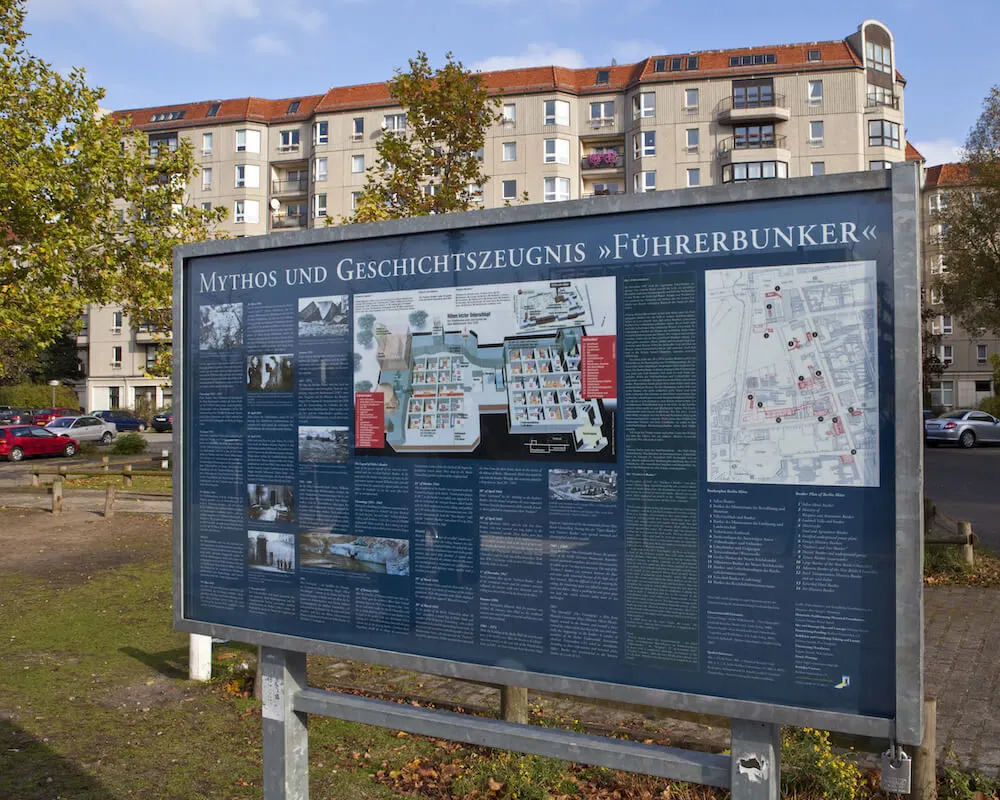
Hitler's Bunker
 Highlight of Guided Walking Tour of WW2 & Cold War
Highlight of Guided Walking Tour of WW2 & Cold War The site of the bunkers where the Nazi leadership holed up during the final days of World War II, and where Hitler committed suicide on April 30th, 1945.
Located in the very center of Berlin, it may seem strange that such a valuable piece of real estate and historically significant site is left as a parking lot, but its association with Hitler makes it unsuitable to any other use. The site was previously left completely unmarked, in order to prevent it from becoming a shrine to modern-day Nazis. Now at least an information board stands at the spot.

Reichstag
 Highlight of Guided Walking Tour of WW2 & Cold War
Highlight of Guided Walking Tour of WW2 & Cold War Make your way to the top of the dome enjoying amazing views and looking down at debating members of the German Parliament below.
Officially, the Reichstag is actually the Bundestag, which means the federal parliament. The Reichstag was reduced to a ruined shell by arson in 1933 and by World War II fighting, but it was rebuilt with a striking egg-shaped glass dome. Visitors are given a free audio guide that discusses the building’s history and architecture, while also orientating you to the sites of Berlin. It is an excellent introduction to the city. Note that it is usually necessary to book well in advance!

Holocaust Memorial
 Highlight of Guided Walking Tour of WW2 & Cold War
Highlight of Guided Walking Tour of WW2 & Cold War Wander amongst 2,711 columns forming a vast mazelike Holocaust memorial.
The Memorial to the Murdered Jews of Europe. It consists of a 19,000 square meter site with over 2700 concrete slabs that grow larger and more ominous as you approach the center of the monument. Beneath the monument lies an information center.

Topography of Terror
 Highlight of Guided Walking Tour of WW2 & Cold War
Highlight of Guided Walking Tour of WW2 & Cold War Learn about the horrors of Nazism and the security apparatus it used to enforce its will in this documentation center.
The center has free admission. It is located on a site that headquartered Adolf Hitler's elite killers, the SS, the Gestapo secret police and the Reich Main Security Office, making it the main cog in the Nazi security regime. Standing there today in testament to the evil perpetrated during those years is the Topography of Terror, Germany’s most significant museum on the agents of Nazi terror.

Hitler's Bunker
 Highlight of Guided Walking Tour of WW2 & Cold War
Highlight of Guided Walking Tour of WW2 & Cold War The site of the bunkers where the Nazi leadership holed up during the final days of World War II, and where Hitler committed suicide on April 30th, 1945.
Located in the very center of Berlin, it may seem strange that such a valuable piece of real estate and historically significant site is left as a parking lot, but its association with Hitler makes it unsuitable to any other use. The site was previously left completely unmarked, in order to prevent it from becoming a shrine to modern-day Nazis. Now at least an information board stands at the spot.

Reichstag
 Highlight of Guided Walking Tour of WW2 & Cold War
Highlight of Guided Walking Tour of WW2 & Cold War Make your way to the top of the dome enjoying amazing views and looking down at debating members of the German Parliament below.
Officially, the Reichstag is actually the Bundestag, which means the federal parliament. The Reichstag was reduced to a ruined shell by arson in 1933 and by World War II fighting, but it was rebuilt with a striking egg-shaped glass dome. Visitors are given a free audio guide that discusses the building’s history and architecture, while also orientating you to the sites of Berlin. It is an excellent introduction to the city. Note that it is usually necessary to book well in advance!

Holocaust Memorial
 Highlight of Guided Walking Tour of WW2 & Cold War
Highlight of Guided Walking Tour of WW2 & Cold War Wander amongst 2,711 columns forming a vast mazelike Holocaust memorial.
The Memorial to the Murdered Jews of Europe. It consists of a 19,000 square meter site with over 2700 concrete slabs that grow larger and more ominous as you approach the center of the monument. Beneath the monument lies an information center.
prev
next


Day 9
Berlin
View More
Day 9
Berlin


Morning to Late Afternoon
Excursion to the Sachsenhausen Concentration Camp
The Nazi regime interred over 200,000 people in the Sachsenhausen concentration camp. As the closest camp to Berlin, it was primarily used for political prisoners but also held Jews, prisoners of war, and others. After the Soviets liberated the camp over 60,000 Nazis were interned there in turn. Visitors see recreated camp barracks, the original prisoner kitchens where the prisoners scribbled graffiti onto the walls, crematory ovens, and a multi-media presentation of “everyday life in the camp” narrated by former prisoners.

Day 9
Berlin
View More


Day 10
Depart Berlin
View More
Day 10
Depart Berlin

To Be Determined
Transfer to Berlin Airport by Taxi or Train
The most affordable and fast way to reach Berlin Brandenburg airport is by train. The Airport Express train takes only 30 minutes and leaves directly from the main station in central Berlin (Berlin Hbf). Regional and S-Bahn trains also depart from other locations in Berlin. Berlin taxis are generally reliable and honest, so you may wish to take a taxi or Uber, although this is more expensive than the train and puts you at the mercy of traffic. You can also arrange a private transfer. If you are picked up about 3 hours before your departure time, you should arrive at the airport with about two hours to spare, depending on traffic. If you are leaving during rush hour, you may want to budget an extra fifteen to thirty minutes.
Day 10
Depart Berlin
View More


What's Included In Your Trip

Pre-Paid Tours and Activities:
- Prague Castle & Royal Route Guided Walk
- Guided Tour of Velvet Revolution Sites
- Highlights of Berlin Guided Walking Tour
- Berlin in World War II and the Cold War - A Guided Tour
- City Card for Berlin, including discounts to many popular attractions

Pre-Paid Transportation:
- 2nd Class Train Tickets from Prague to Dresden
- 2nd Class Train Tickets from Dresden to Berlin
- Public Transport Tickets for Berlin

Accommodation:
- 5 nights at a hotel of your choice in Prague
- 6 nights at a hotel of your choice in Berlin

Go Real Travel Mobile App:
- Itinerary Plan & Reservations Info
- Points of Interest
- Detailed Travel Information
- Maps & Directions
Other Trips You May Like

10 Days
From$1927USD
Rivers and Revelries in the Cultural Capitals of Central Europe - Berlin, Prague & Budapest

Germany, Czech Republic, Hungary

12 Days
From$2449USD
12 Days in the Heart of Central Europe: Berlin, Prague, Vienna, and Munich

Germany, Czech Republic, Austria

14 Days
From$2875USD
2-Week Journey Through Central & Eastern Europe: History

Germany, Czech Republic, Austria, Hungary, Poland

15 Days
From$3249USD
Timeless Central Europe:: From Berlin to Vienna through the Czech Republic

Germany, Czech Republic, Austria

7 Days
From$1495USD
One Week in Berlin & Prague: See the Highlights and Experience the Local Scene

Germany, Czech Republic

7 Days
From$1195USD

11 Days
From$2045USD
11 Day Itinerary in Berlin, Prague & Vienna: Castles, Palaces, and Much More

Germany, Czech Republic, Austria

9 Days
From$2240USD
Capitals, Canals, and Castles: A 9-Day Tour of Amsterdam, Berlin, and Prague

Netherlands, Germany, Czech Republic

10 Days
From$1995USD
An Active Adventure to Berlin, Dresden, Prague, and the Saxon Switzerland

Germany, Czech Republic

10 Days
From$1927USD
Rivers and Revelries in the Cultural Capitals of Central Europe - Berlin, Prague & Budapest

Germany, Czech Republic, Hungary

12 Days
From$2449USD
12 Days in the Heart of Central Europe: Berlin, Prague, Vienna, and Munich

Germany, Czech Republic, Austria

14 Days
From$2875USD
2-Week Journey Through Central & Eastern Europe: History

Germany, Czech Republic, Austria, Hungary, Poland

15 Days
From$3249USD
Timeless Central Europe:: From Berlin to Vienna through the Czech Republic

Germany, Czech Republic, Austria

7 Days
From$1495USD
One Week in Berlin & Prague: See the Highlights and Experience the Local Scene

Germany, Czech Republic

7 Days
From$1195USD

11 Days
From$2045USD
11 Day Itinerary in Berlin, Prague & Vienna: Castles, Palaces, and Much More

Germany, Czech Republic, Austria

9 Days
From$2240USD
Capitals, Canals, and Castles: A 9-Day Tour of Amsterdam, Berlin, and Prague

Netherlands, Germany, Czech Republic

10 Days
From$1995USD
An Active Adventure to Berlin, Dresden, Prague, and the Saxon Switzerland

Germany, Czech Republic
prev
next
Featured Blogs
prev
next
Our Customers Say It Best
Otto Chuy, Los Angeles, California
I am still surprised how everything worked as planned, without a hitch. All instructions in your itinerary were precise and correct. Your suggestions and comments in each of the locations we went to were very helpful. All your guides, without exception, were wonderful and exactly on time. 

Kathy Mongeau, Ottawa, Ontario
My sister, Ann Ibberson, and I have been back home for a few weeks now and still go on and on about our fabulous trip. We were just blown away in every respect. Given the fact that we only had 1 ½ weeks, you had everything arranged for us so efficiently and your contacts who we dealt with for transfers, tours, hotels were extremely professional and personable. Things could not have gone better. 

Clive Andrew, Brisbane, Queensland
Just a quick note to let you know that I am back home now after probably the best overseas holiday that I have ever had, in no small part due to your very capable organization booking of hotels, tours, & trains. There was just nothing that went wrong with the timings etc. 

Malini Dutta, Boston, Massachusetts
We can't thank you enough for the detailed plans, maps, and suggestions. It really felt that someone was holding our hands and showing us around. We had all the excitement of discovering foreign lands, with none of the problems that can happen while negotiating unfamiliar places. In fact, all the cities felt like home within a few hours of arriving and exploring. 

Bev and Mark Frankel, Williamsburg, Virginia
We could not be more pleased with Go Real Travel! You took the guess work out of things like public transport but still managed to allow us the freedom to tour as we wanted. Our guides were exceptional and every time I saw a Viking Cruise tour of 25 people, I realized the quality experience we were getting with Go Real. 

Marianne Strydom, Paarl, South Africa
I just wanted to thank you for organizing an amazing trip for me – I packed in so much in such a short period of time and everything was just perfect. The way you do things makes it possible to really get to know the destination, which for me as a travel agent could not have been better. 

Otto Chuy, Los Angeles, California
I am still surprised how everything worked as planned, without a hitch. All instructions in your itinerary were precise and correct. Your suggestions and comments in each of the locations we went to were very helpful. All your guides, without exception, were wonderful and exactly on time. 

Kathy Mongeau, Ottawa, Ontario
My sister, Ann Ibberson, and I have been back home for a few weeks now and still go on and on about our fabulous trip. We were just blown away in every respect. Given the fact that we only had 1 ½ weeks, you had everything arranged for us so efficiently and your contacts who we dealt with for transfers, tours, hotels were extremely professional and personable. Things could not have gone better. 

Clive Andrew, Brisbane, Queensland
Just a quick note to let you know that I am back home now after probably the best overseas holiday that I have ever had, in no small part due to your very capable organization booking of hotels, tours, & trains. There was just nothing that went wrong with the timings etc. 

Malini Dutta, Boston, Massachusetts
We can't thank you enough for the detailed plans, maps, and suggestions. It really felt that someone was holding our hands and showing us around. We had all the excitement of discovering foreign lands, with none of the problems that can happen while negotiating unfamiliar places. In fact, all the cities felt like home within a few hours of arriving and exploring. 

Bev and Mark Frankel, Williamsburg, Virginia
We could not be more pleased with Go Real Travel! You took the guess work out of things like public transport but still managed to allow us the freedom to tour as we wanted. Our guides were exceptional and every time I saw a Viking Cruise tour of 25 people, I realized the quality experience we were getting with Go Real. 

Marianne Strydom, Paarl, South Africa
I just wanted to thank you for organizing an amazing trip for me – I packed in so much in such a short period of time and everything was just perfect. The way you do things makes it possible to really get to know the destination, which for me as a travel agent could not have been better. 



Explore cities in more detail
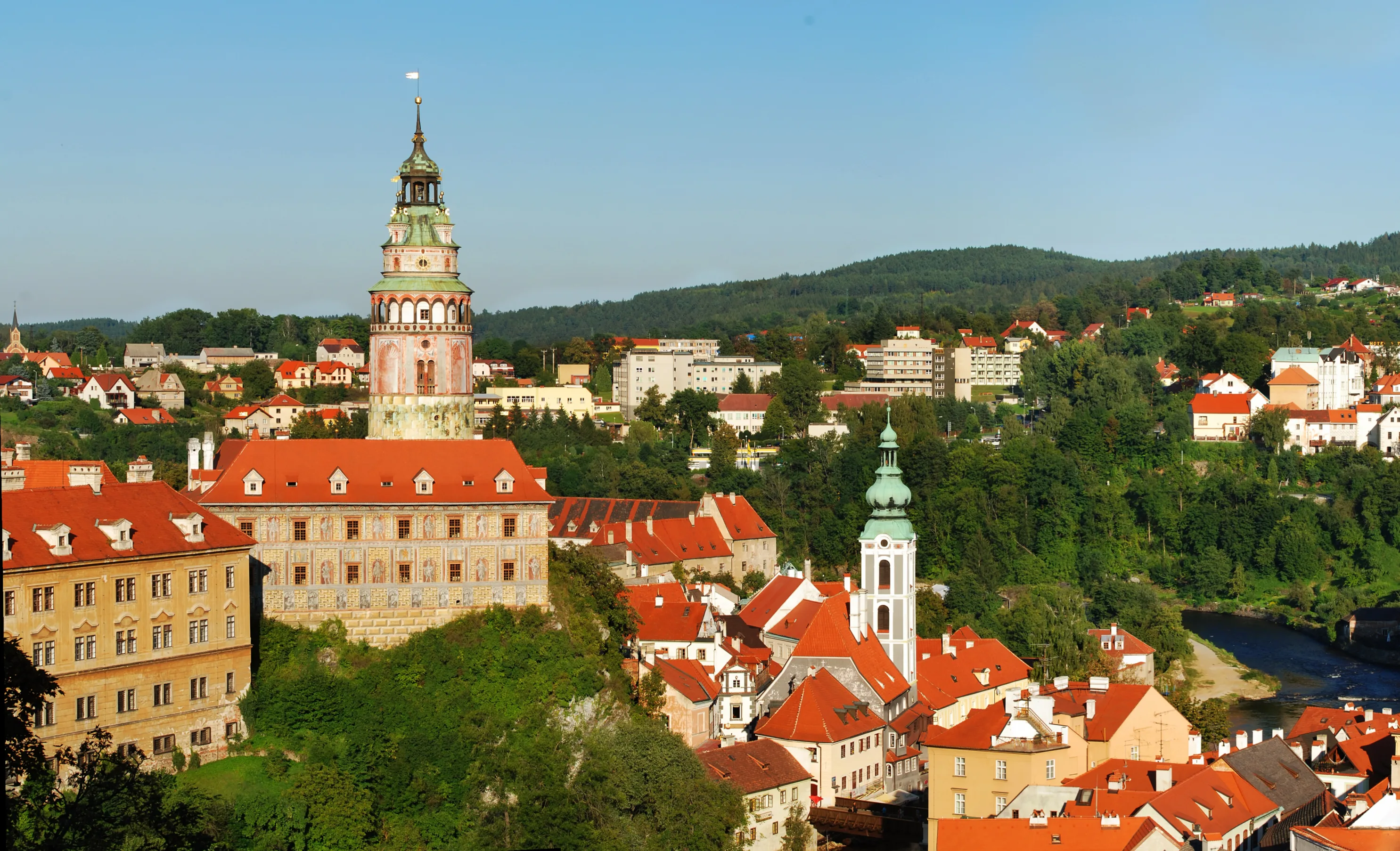
Cesky Krumlov
Cesky Krumlov is a charming little town in South Bohemia. It might be small, but it’s full of whimsical character and mystery. Walking through the narrow streets and across the bridge, the views of the medieval Cesky Krumlov Castle will take your breath away. At night, street musicians serenade visitors on the bridge where you can dance beneath the stars and the watchful eye of the magnificent tower. Dozens of unique local artisan shops, cafes, and restaurants are woven among the winding streets. In the summer, the city is lush with life and greenery. Rafters race down the river, stopping in the center along the way to enjoy a hearty meal before continuing their journey. In the winter, the main square transforms into a magnificent Christmas market and light blankets of snow cover the rooftops. This quaint little town will exceed your expectations and you may never want to leave.
Read More
Learn About Cesky Krumlov
Build Cesky Krumlov Trip

Dresden
Nearly every wall and rooftop in Dresden seems to be finished with a flourish. Defined by its ornamental baroque architecture, a power statement of Saxon royalty, Dresden is made all the more miraculous considering the city was leveled by firebombing in WWII. After the war, the city was reconstructed, brick by painstaking brick. Even under East German-Soviet rule, which usually eschewed frivolous design, buildings like the Semper Opera House were pieced back to their former glory. Restoration of the majestic Zwinger Palace and bell domed Church of Our Lady slowly followed, with the Frauenkirche only fully repaired in 2005. Arguably there is no other city in Europe that cherishes its hard-won architecture as much as Dresden. Although it is a compact city, so many of its buildings will stop you in your tracks that architecture fans will easily lose a whole day in the Old Town area. Especially during the winter months, Dresden sparkles with a joyous, uplifting ambiance. The city is recognized as having the best-ever Christmas market in all of Europe. Between the twinkling lights, the scent of hot wine and gingerbread, and the towering Christmas tree, it’s worth going out of your way to see Dresden at this time of year.
Read More
Learn About Dresden
Build Dresden Trip

Nuremberg
One of the most authentic, storied German destinations, Nuremberg's picturesque old town, glorious castle, and buzzing Christmas Market makes this city a time-true classic. The ideal gateway to old Bavaria, Nuremberg offers a primer in German history before you embark on the lovely journey through old Bavaria, known as the Romantic Road. Considered the capital of the Holy Roman Empire in the middle ages, Nuremberg would have felt like the center of the world as a procession of kings and emperors passed through its magnificent gates. When the German Renaissance came, Nuremberg was at its heart. Albrecht Dürer, the great German master artist, was born here, and Martin Luther called Nuremberg Germany's 'eyes and ears'. Skip forward a few centuries, and the city took a dark turn, as Nuremberg became a gathering point for the German National Socialists. Slightly outside of town, you can still find the Nazi Party Rallying Grounds, a sobering reminder of the not so distant past. If it all gets too heavy, you can end the day with a glass of rotbier (red beer) and mull it over. Nuremberg is a must-see for anyone who wants to delve into Germany's past.
Read More
Learn About Nuremberg
Build Nuremberg Trip

Prague
The city of Prague is indisputably the gem of Central Europe. Full of history, culture, and classic Czech pubs around every corner, Prague is teeming with nooks and crannies just waiting to be discovered. The narrow cobblestone streets and warm red rooftops give the city a homey feel, while the well-preserved medieval architecture transports you back in time. Walking across the Charles Bridge with the view of the Prague Castle will make you feel like you’re living in a fairytale, and you might as well be. As an up-and-coming destination, Prague is a perfect mix of classic and modern. New trendy cafes and bistros are always popping up, and you can always find a group of lively locals chowing down on goulash and quaffing pivo (the best beer in Europe!) at traditional Czech restaurants across the city. The clash of modernity and tradition, preservation and innovation, gives this city a mysterious air that you won’t soon forget.
Read More
Learn About Prague
Build Prague Trip
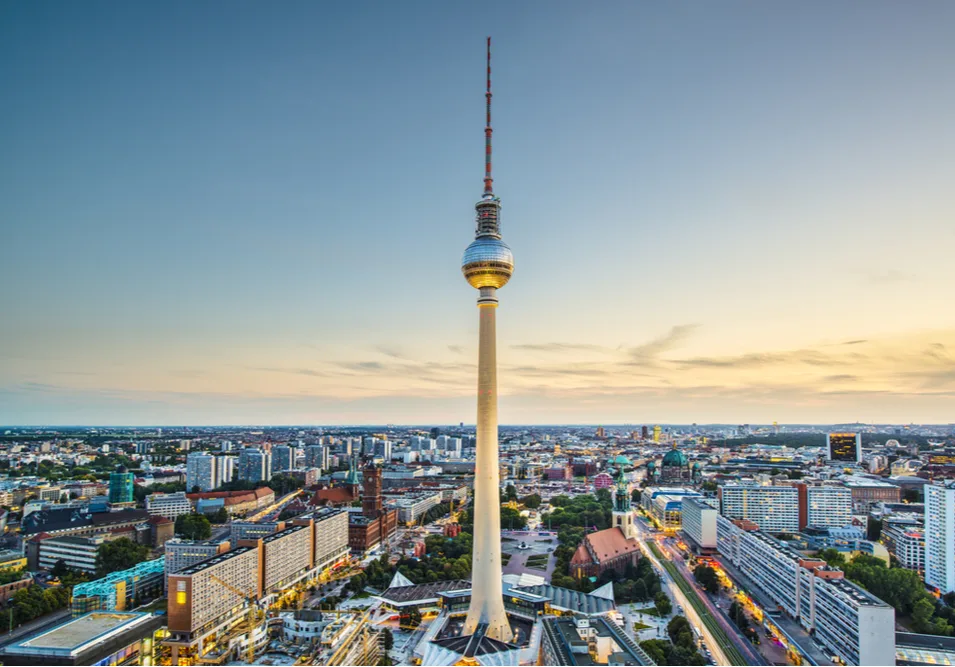
Berlin
Since the fall of its notorious wall, Berlin’s unification has seen it go from strength to strength. No wonder the city feels like it hasn’t stopped partying since the 1990s. There is so much to celebrate here. Fueled by the robust economy, a thriving tech scene, and straight-up German bonhomie, when you step into Berlin you’ll soon be caught up in its spirit. For all this gusto, Berlin hasn’t forgotten its troubled past. A visit to Berlin is to bear witness to history. Portions of the wall remain intact, and the city’s Jewish Museum offers a detailed, emotional examination of the Holocaust. Inside the reconstructed Reichstag, every attempt has been made to preserve the parliament’s beleaguered history. The buildings' glass dome addition feels less like a triumphal crown and more like a freshly healed battle scar. Days in Berlin are easily spent wandering from a cafe to the cultural institutions on Museum Island, or over to the Charlottenburg Palace. By night, crowds wander through the booming bars and nightclubs or gaze upon the floodlit Brandenburg Gate and Victory Column monuments. An international city that can offer something to everyone, Berlin is an unmissable stop on your German journey.
Read More
Learn About Berlin
Build Berlin Trip

Vienna
Artistic and musical, historical and elegant, Vienna is the definition of class. The seat of the Habsburg monarchy for over six centuries, it's no wonder this city is still fit for royalty. Baroque buildings and imperial palaces dominate the cityscape, while locals stride gracefully through the streets, likely on their way to a classical music concert or art exhibition. Visitors from all over the world flock to Schonbrunn Palace, historical museums, and local eateries for authentic Viennese schnitzel. Vienna is also home to world-class wining and dining. Famous dishes include Wiener schnitzel, Tafelspitz (prime boiled beef), and apfelstrudel (apple strudel), all of which pair well with a glass of fine Austrian wine. No matter how long you spend in Vienna, you'll leave with a new appreciation for the finer things in life.
Read More
Learn About Vienna
Build Vienna Trip

Cesky Krumlov
Cesky Krumlov is a charming little town in South Bohemia. It might be small, but it’s full of whimsical character and mystery. Walking through the narrow streets and across the bridge, the views of the medieval Cesky Krumlov Castle will take your breath away. At night, street musicians serenade visitors on the bridge where you can dance beneath the stars and the watchful eye of the magnificent tower. Dozens of unique local artisan shops, cafes, and restaurants are woven among the winding streets. In the summer, the city is lush with life and greenery. Rafters race down the river, stopping in the center along the way to enjoy a hearty meal before continuing their journey. In the winter, the main square transforms into a magnificent Christmas market and light blankets of snow cover the rooftops. This quaint little town will exceed your expectations and you may never want to leave.
Read More
Learn About Cesky Krumlov
Build Cesky Krumlov Trip

Dresden
Nearly every wall and rooftop in Dresden seems to be finished with a flourish. Defined by its ornamental baroque architecture, a power statement of Saxon royalty, Dresden is made all the more miraculous considering the city was leveled by firebombing in WWII. After the war, the city was reconstructed, brick by painstaking brick. Even under East German-Soviet rule, which usually eschewed frivolous design, buildings like the Semper Opera House were pieced back to their former glory. Restoration of the majestic Zwinger Palace and bell domed Church of Our Lady slowly followed, with the Frauenkirche only fully repaired in 2005. Arguably there is no other city in Europe that cherishes its hard-won architecture as much as Dresden. Although it is a compact city, so many of its buildings will stop you in your tracks that architecture fans will easily lose a whole day in the Old Town area. Especially during the winter months, Dresden sparkles with a joyous, uplifting ambiance. The city is recognized as having the best-ever Christmas market in all of Europe. Between the twinkling lights, the scent of hot wine and gingerbread, and the towering Christmas tree, it’s worth going out of your way to see Dresden at this time of year.
Read More
Learn About Dresden
Build Dresden Trip

Nuremberg
One of the most authentic, storied German destinations, Nuremberg's picturesque old town, glorious castle, and buzzing Christmas Market makes this city a time-true classic. The ideal gateway to old Bavaria, Nuremberg offers a primer in German history before you embark on the lovely journey through old Bavaria, known as the Romantic Road. Considered the capital of the Holy Roman Empire in the middle ages, Nuremberg would have felt like the center of the world as a procession of kings and emperors passed through its magnificent gates. When the German Renaissance came, Nuremberg was at its heart. Albrecht Dürer, the great German master artist, was born here, and Martin Luther called Nuremberg Germany's 'eyes and ears'. Skip forward a few centuries, and the city took a dark turn, as Nuremberg became a gathering point for the German National Socialists. Slightly outside of town, you can still find the Nazi Party Rallying Grounds, a sobering reminder of the not so distant past. If it all gets too heavy, you can end the day with a glass of rotbier (red beer) and mull it over. Nuremberg is a must-see for anyone who wants to delve into Germany's past.
Read More
Learn About Nuremberg
Build Nuremberg Trip

Prague
The city of Prague is indisputably the gem of Central Europe. Full of history, culture, and classic Czech pubs around every corner, Prague is teeming with nooks and crannies just waiting to be discovered. The narrow cobblestone streets and warm red rooftops give the city a homey feel, while the well-preserved medieval architecture transports you back in time. Walking across the Charles Bridge with the view of the Prague Castle will make you feel like you’re living in a fairytale, and you might as well be. As an up-and-coming destination, Prague is a perfect mix of classic and modern. New trendy cafes and bistros are always popping up, and you can always find a group of lively locals chowing down on goulash and quaffing pivo (the best beer in Europe!) at traditional Czech restaurants across the city. The clash of modernity and tradition, preservation and innovation, gives this city a mysterious air that you won’t soon forget.
Read More
Learn About Prague
Build Prague Trip

Berlin
Since the fall of its notorious wall, Berlin’s unification has seen it go from strength to strength. No wonder the city feels like it hasn’t stopped partying since the 1990s. There is so much to celebrate here. Fueled by the robust economy, a thriving tech scene, and straight-up German bonhomie, when you step into Berlin you’ll soon be caught up in its spirit. For all this gusto, Berlin hasn’t forgotten its troubled past. A visit to Berlin is to bear witness to history. Portions of the wall remain intact, and the city’s Jewish Museum offers a detailed, emotional examination of the Holocaust. Inside the reconstructed Reichstag, every attempt has been made to preserve the parliament’s beleaguered history. The buildings' glass dome addition feels less like a triumphal crown and more like a freshly healed battle scar. Days in Berlin are easily spent wandering from a cafe to the cultural institutions on Museum Island, or over to the Charlottenburg Palace. By night, crowds wander through the booming bars and nightclubs or gaze upon the floodlit Brandenburg Gate and Victory Column monuments. An international city that can offer something to everyone, Berlin is an unmissable stop on your German journey.
Read More
Learn About Berlin
Build Berlin Trip

Vienna
Artistic and musical, historical and elegant, Vienna is the definition of class. The seat of the Habsburg monarchy for over six centuries, it's no wonder this city is still fit for royalty. Baroque buildings and imperial palaces dominate the cityscape, while locals stride gracefully through the streets, likely on their way to a classical music concert or art exhibition. Visitors from all over the world flock to Schonbrunn Palace, historical museums, and local eateries for authentic Viennese schnitzel. Vienna is also home to world-class wining and dining. Famous dishes include Wiener schnitzel, Tafelspitz (prime boiled beef), and apfelstrudel (apple strudel), all of which pair well with a glass of fine Austrian wine. No matter how long you spend in Vienna, you'll leave with a new appreciation for the finer things in life.
Read More
Learn About Vienna
Build Vienna Trip
prev
next


 Map of Your Itinerary Route
Map of Your Itinerary Route
Zoom In to the cities to see your itinerary in more detail


 4.8
4.8 







